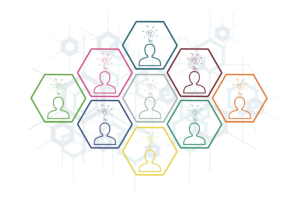Ideas, Managed
Idea generation is just one step in the innovation process. But just how can one manage the flow of ideas, and ultimately generate workable and measurable ideas that turn into actual solutions? Itonics, in its blog “The Ultimate Guide to Ideation,” looks at the difference between ideation and a more structured idea management process: “While ideation generally describes the creative, multi-stage methodology of idea generation, we understand idea management to be more of an operational process in the corporate context for the systematic generation, enrichment, evaluation, and management of ideas in all phases of the innovation process.”
Itonics further notes that idea management aims to generate, assess, and improve ideas that contribute to an organization’s innovation strategy. This includes the prioritization and implementation of ideas. Idea management can occur through a centralized or decentralized process. Centralized idea management allows an entire organization to engage in the process, whereas decentralized idea management allows different teams or business units to manage their own ideas. Perhaps one can sum up that idea management takes a more collaborative approach to the creation of ideas process, a process that can involve both internal and external stakeholders.
This ideation/idea management process can be broken down into several components, Itonics recommends. This may also depend on the roles of each member of the ideation and innovation team.
- Choose a challenge or opportunity space
- Set up an ideation challenge
- Define phase-gate process
- Generate and validate ideas
- Transform ideas into concepts
- Implement the promising ventures
- Reward and recognize
Perhaps most challenging, Itonics points out that ideation still needs to be measured in some way to gauge success. Idea management must have a strategic basis and so one must justify and align activities with desired future goals. This in turn leads to “actionable innovation metrics that must be relative (input/output) and time-bound to identify actual progress. They should relate to specific goals that provide direction for innovative activities. Based on these characteristics, actionable KPIs indicate possible directions for change. This means either taking action to increase participant engagement or to improve process efficiency and effectiveness.”
Fueling Innovation
All Things Innovation recently looked at “Generating Innovation Through Ideation.” Ideation is often confused with innovation. Both innovation and ideation are often connected by the organization’s research and development efforts. Ideation, then, is a creative stage of the innovation process where new ideas and concepts are generated. Innovation involves the process of turning those ideas into doing something new or faster, better and cheaper. Ideation fuels innovation.
In “Create A Blueprint for Success With Innovation Frameworks” we further examined various innovation frameworks and management structures that start with ideation. It’s not enough anymore to just throw an idea onto the wall and hope it will stick. Instead, these flexible and agile frameworks are a strategic structure designed to give the enterprise and the innovation team the ability to tap into ideas. One can then evaluate the strengths and weaknesses of each idea, sharpen the decision-making around each idea generated and build strategies to turn them into value-generating opportunities.
Making an Impact
Idea management plays a crucial role in the ideation and innovation process, providing a structured approach to collecting, evaluating, and implementing ideas. We asked ChatGPT to outline key benefits of idea management in the context of innovation:
- Systematic Innovation Process: Idea management provides a systematic and organized approach to the innovation process. It helps teams move from random brainstorming to a more structured method of generating, capturing, and evaluating ideas.
- Idea Generation: One of the primary benefits is the facilitation of idea generation. By encouraging employees to contribute ideas, organizations can tap into the collective creativity of their workforce, leading to a diverse range of innovative concepts.
- Employee Engagement: Involving employees in the ideation process through idea management fosters a sense of ownership and engagement.
- Identification of Promising Concepts: Idea management allows for the systematic evaluation of ideas to identify those with the most potential for success. This process helps organizations focus their resources on the most promising and viable innovations.
- Efficient Resource Allocation: By prioritizing and selecting the most promising ideas, organizations can allocate resources more efficiently. This ensures that time, money, and effort are directed toward initiatives that are more likely to yield positive outcomes.
- Continuous Improvement: Idea management supports a culture of continuous improvement by encouraging ongoing feedback and refinement of ideas. This iterative process contributes to the evolution of concepts and enhances the likelihood of successful implementation.
- Enhanced Communication and Collaboration: The idea management process promotes communication and collaboration among team members. Cross-functional collaboration can lead to the synthesis of different perspectives, resulting in more robust and comprehensive solutions.
- Risk Mitigation: Evaluating and refining ideas systematically helps in identifying and mitigating potential risks early in the innovation process. This proactive approach minimizes the likelihood of unexpected challenges during implementation.
- Documentation of Knowledge: Idea management platforms often serve as repositories for ideas, discussions, and feedback. This documentation of knowledge is valuable for future reference, enabling organizations to build upon previous ideas and experiences.
- Cultural Impact: Implementing idea management practices can contribute to a culture of innovation within an organization. When employees see that their ideas are taken seriously and that innovation is encouraged, it fosters a positive and forward-thinking work environment.
Operationalizing Ideas
In the context of ideation and innovation, idea management is a structured way to operationalize the generation of ideas, taking it beyond simple brainstorming and instead creating a framework or formula to build upon. This systematic innovation process engages employees in idea generation. This in turn will help with the identification of promising concepts, streamline continuous improvement, and enhance collaboration, among other benefits.
Video courtesy of Idea Drop
Contributor
-

Matthew Kramer is the Digital Editor for All Things Insights & All Things Innovation. He has over 20 years of experience working in publishing and media companies, on a variety of business-to-business publications, websites and trade shows.
View all posts











































































































































































